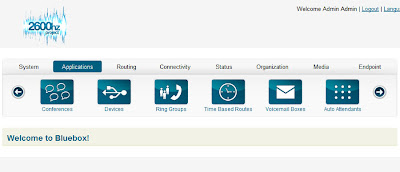Your VoIP Your Way With Blue.Box At 2600Hz.org
Your VoIP Your Way With BlueBox http://snapvoip.blogspot.com/
I just came across an Open Source VoIP IP Telephony initiative, that look to me very promising. Blue.Box is a configuration and management software utilizing the FreeSWITCH and Asterisk switching libraries. Blue.Box supports multi-tenancy, and supports database and file replication to scale up to thousands of registered devices and simultaneous phone calls. Blue.Box is equally geared to operate in the cloud or on the premise.
Operating under 2600Hz.org, (see below for an explanation of 2600Hz and the connection to the blue.box) the Open Source initiative brings together FreeSWITCH, Asterisk and YATE switching libraries currently centered around blue.box project. They also have other software such as;
The blue.box is available to download as a ready build ISO, Blue.Box 1.0.1, as RPMs for CentOS, Redhat and Fedora Linux distributions. Source is also available via git.
If you download the ISO be watchful. It is not a live CD, the CentOS based ISO is set up for unattended installation and will format your hard drive and partition automatically before installing the software distribution. You might lose your OS and other software on the computer..
The Blue.Box ISO comes with: CentOS 5.5 x86_64, FreeSWITCH 1.06, FreeSWITCH Sound files, Blue.Box 1.0, Apache 2.2.3, MySQL 5.1.46, and PHP 5.3.2.
The 2600hz and the blue.box project
The 2600Hz and the Blue Box;
I just came across an Open Source VoIP IP Telephony initiative, that look to me very promising. Blue.Box is a configuration and management software utilizing the FreeSWITCH and Asterisk switching libraries. Blue.Box supports multi-tenancy, and supports database and file replication to scale up to thousands of registered devices and simultaneous phone calls. Blue.Box is equally geared to operate in the cloud or on the premise.
Operating under 2600Hz.org, (see below for an explanation of 2600Hz and the connection to the blue.box) the Open Source initiative brings together FreeSWITCH, Asterisk and YATE switching libraries currently centered around blue.box project. They also have other software such as;
Nibble Billing – FreeSWITCH module for simple real-time per-minute billingBut it seems they are still in the preparation.
Asterisk AMI Class – Simple Interface for Asterisk AMI from anywhere
Package Manager – Karl Anderson’s PHP package management system
Doctrine Polymorphic Modules – Dynamically attach and remove model relations in Doctrine
The blue.box is available to download as a ready build ISO, Blue.Box 1.0.1, as RPMs for CentOS, Redhat and Fedora Linux distributions. Source is also available via git.
If you download the ISO be watchful. It is not a live CD, the CentOS based ISO is set up for unattended installation and will format your hard drive and partition automatically before installing the software distribution. You might lose your OS and other software on the computer..
The Blue.Box ISO comes with: CentOS 5.5 x86_64, FreeSWITCH 1.06, FreeSWITCH Sound files, Blue.Box 1.0, Apache 2.2.3, MySQL 5.1.46, and PHP 5.3.2.
The 2600hz and the blue.box project
The 2600Hz and the Blue Box;
2600hz is a frequency that long distance carrier switching equipment formerly used to signal when a long-distance telephone line was not currently in use. It was an important signaling technology in the 60s and 70s. Certain people developed a way to use a device, known as a “blue box”, to generate a 2600 Hz tone on a line that was already in use, tricking the phone company to allow free phone calls to be made by bypassing billing systems when spinning up a new call. More important, however, it was one of the first times that individuals were able to manipulate the telephone system in such a way as to gain direct access to core signaling systems.


1 comments:
user-peer-friend
The most nearly definition that I can understand is that
http://forums.digium.com/viewtopic.php?t=78679
In my opinion the relevand conditions to configure a good SIP VoIP configuration is to have a good programs SIP is like a P2P one, I mean you have opened sip port where the calls come in and you can send calls usually SIP with TCP like a HTTP browsing and the data Voice and Voice-Video with RTP with UDP on ports realtime like 5000 or 8000 not listening you listen with SIP only and pacts sdp texts, opening after the call comes with sip rings and msg, like tigrering NAT games on router, you also need static NAT on your Router to really use a peer like a friend behavior, peer for me is a friend client like zoiper or like other big softphones. So Asterisk say that you can write sip url without have be registered with asterisk, that is a peer something like sip:555@ip_addr_dyn_domain.com, and calling on your own subnetwork with host@ip. So if you are user is asterisk who does it, and you don't have to configure problems with 5060 ports and sdp/rtp 5000 8000, I think asterisk uses push notificatons storing calls registrations not over SIP like a peer only client sip requests half protocol implementation: bad issue. And its like router with users configuration or router with NAT who knows where place calls with ip subnetworks clients registrations. So if asterisk recives the sip packets from a router from internet you can do it like a router-peer-asterisk-peer, or i mean internet-peer-router-peer-lanmobiles-push-users, and so on. Where I can found this configurations, I think asterisk have it, I understand the friend is more explicit cases configurations, like how you can be user and peer on a voip router, asterisk pbx and internet subscription.
Post a Comment